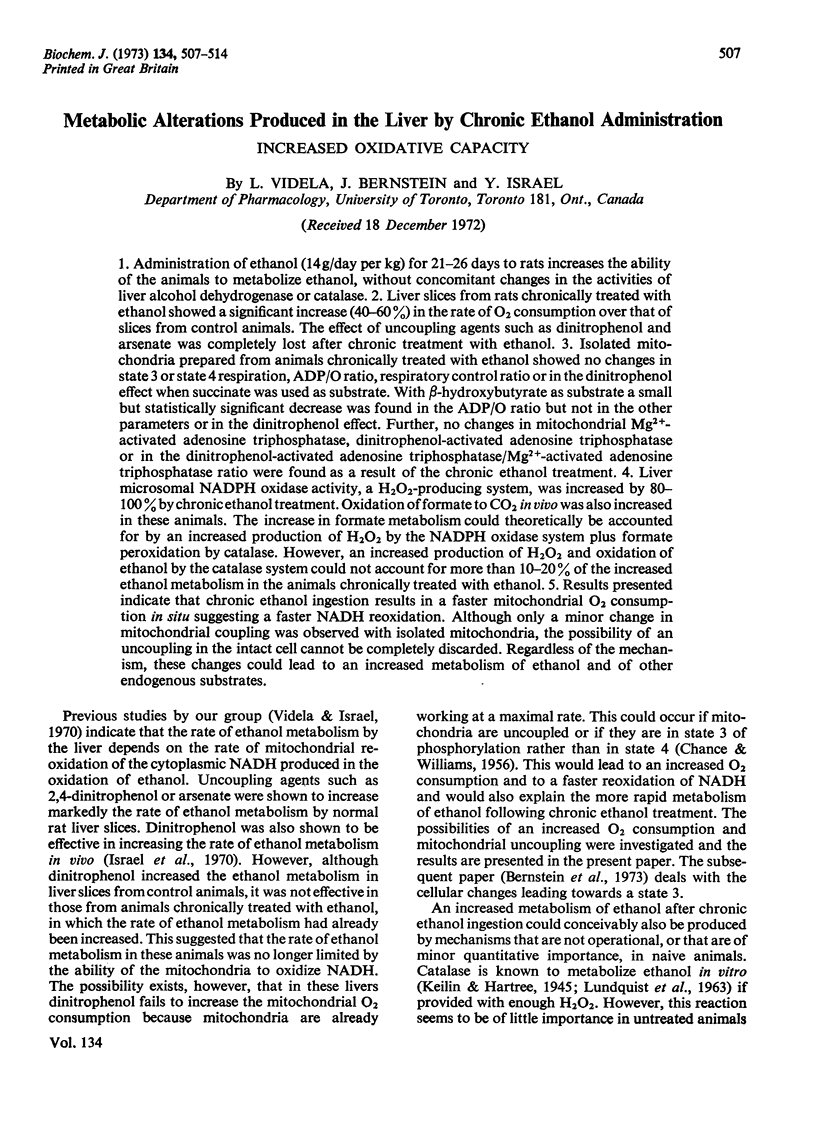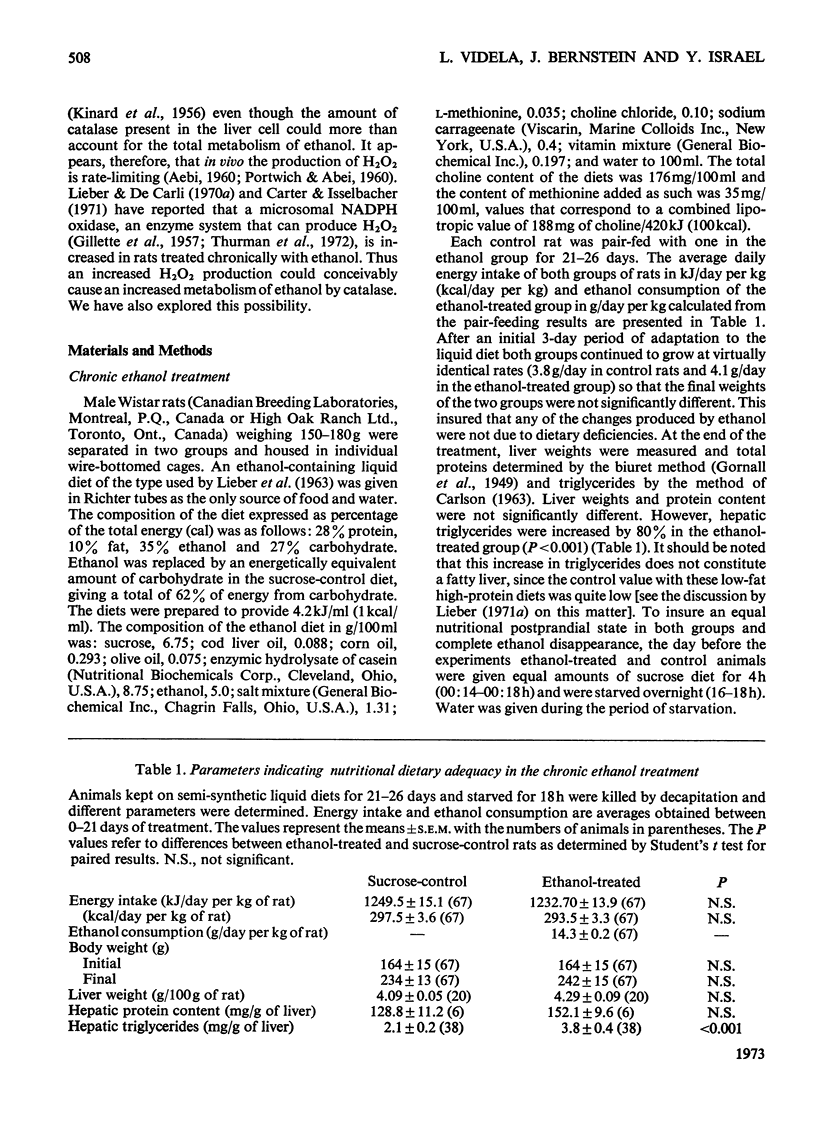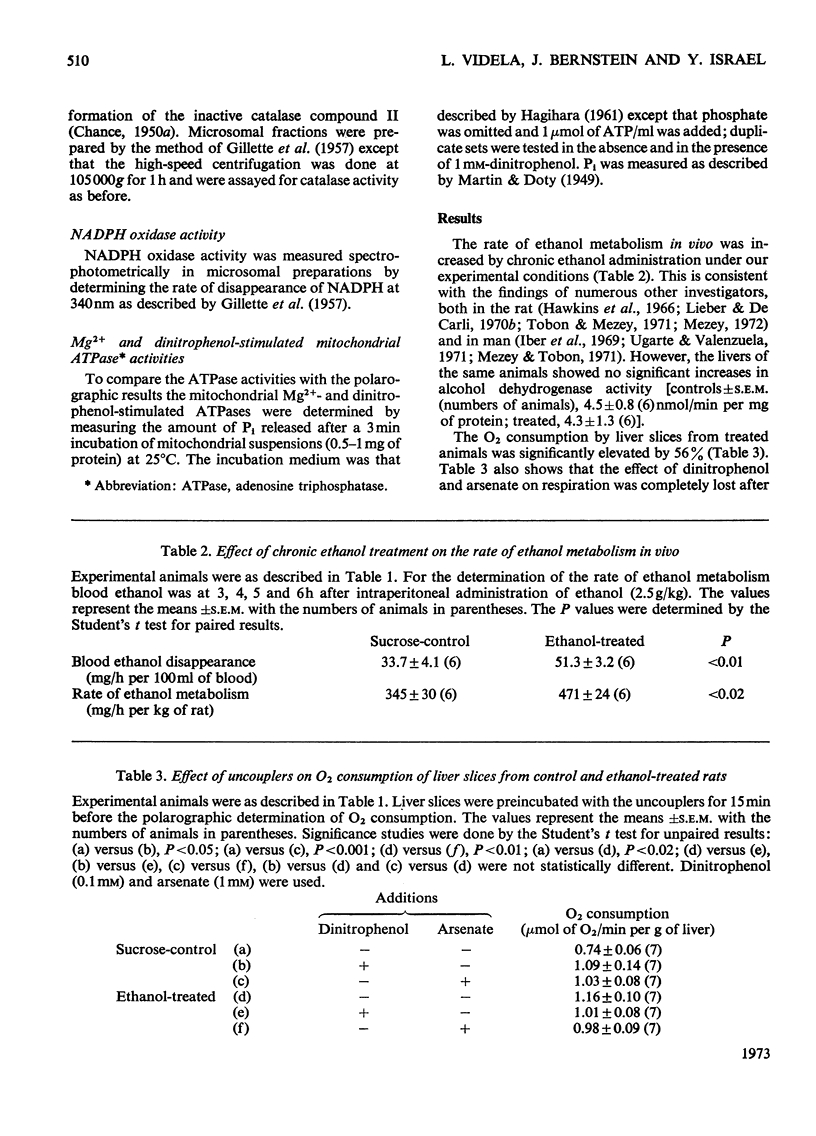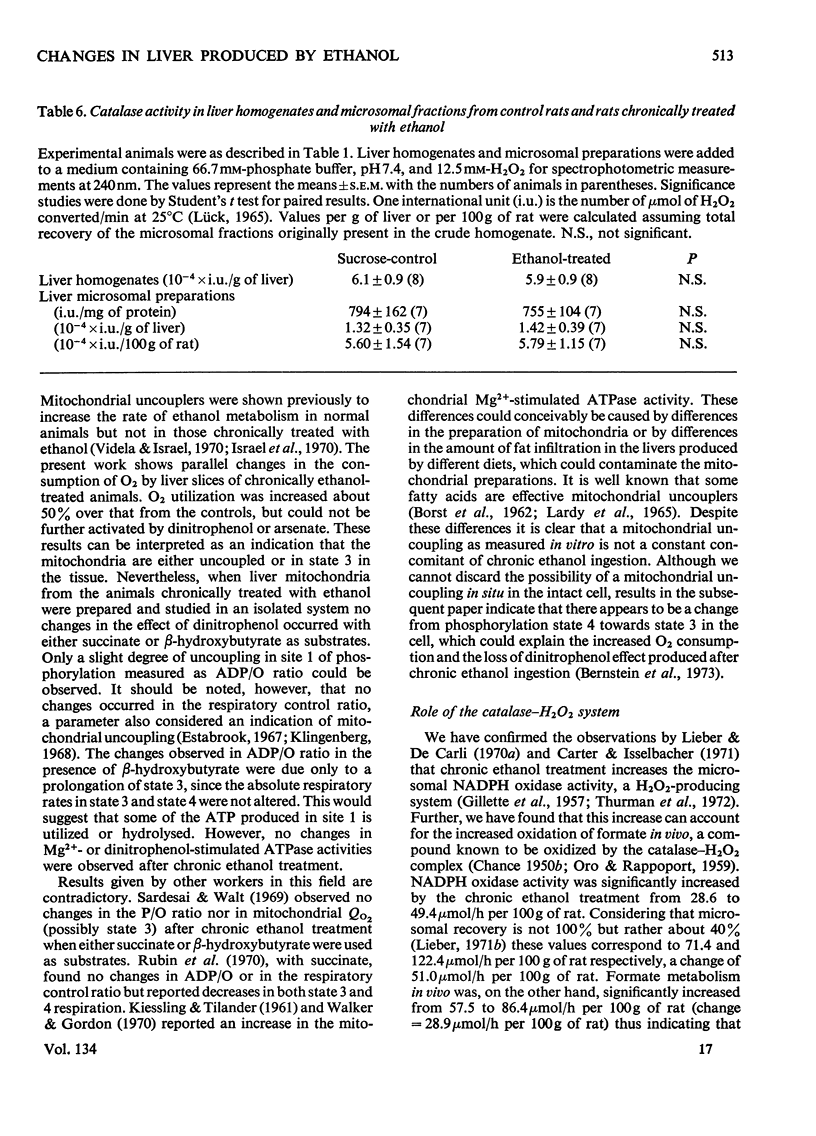Abstract
1. Administration of ethanol (14g/day per kg) for 21–26 days to rats increases the ability of the animals to metabolize ethanol, without concomitant changes in the activities of liver alcohol dehydrogenase or catalase. 2. Liver slices from rats chronically treated with ethanol showed a significant increase (40–60%) in the rate of O2 consumption over that of slices from control animals. The effect of uncoupling agents such as dinitrophenol and arsenate was completely lost after chronic treatment with ethanol. 3. Isolated mitochondria prepared from animals chronically treated with ethanol showed no changes in state 3 or state 4 respiration, ADP/O ratio, respiratory control ratio or in the dinitrophenol effect when succinate was used as substrate. With β-hydroxybutyrate as substrate a small but statistically significant decrease was found in the ADP/O ratio but not in the other parameters or in the dinitrophenol effect. Further, no changes in mitochondrial Mg2+-activated adenosine triphosphatase, dinitrophenol-activated adenosine triphosphatase or in the dinitrophenol-activated adenosine triphosphatase/Mg2+-activated adenosine triphosphatase ratio were found as a result of the chronic ethanol treatment. 4. Liver microsomal NADPH oxidase activity, a H2O2-producing system, was increased by 80–100% by chronic ethanol treatment. Oxidation of formate to CO2 in vivo was also increased in these animals. The increase in formate metabolism could theoretically be accounted for by an increased production of H2O2 by the NADPH oxidase system plus formate peroxidation by catalase. However, an increased production of H2O2 and oxidation of ethanol by the catalase system could not account for more than 10–20% of the increased ethanol metabolism in the animals chronically treated with ethanol. 5. Results presented indicate that chronic ethanol ingestion results in a faster mitochondrial O2 consumption in situ suggesting a faster NADH reoxidation. Although only a minor change in mitochondrial coupling was observed with isolated mitochondria, the possibility of an uncoupling in the intact cell cannot be completely discarded. Regardless of the mechanism, these changes could lead to an increased metabolism of ethanol and of other endogenous substrates.
Full text
PDF







Selected References
These references are in PubMed. This may not be the complete list of references from this article.
- AEBI H. [Mechanism and biological role of the peroxidase action of catalase]. Bull Soc Chim Biol (Paris) 1960;42:187–207. [PubMed] [Google Scholar]
- BORST P., LOOS J. A., CHRIST E. J., SLATER E. C. Uncoupling activity of long-chain fatty acids. Biochim Biophys Acta. 1962 Aug 27;62:509–518. doi: 10.1016/0006-3002(62)90232-9. [DOI] [PubMed] [Google Scholar]
- Bernstein J., Videla L., Israel Y. Metabolic alterations produced in the liver by chronic ethanol administration. Changes related to energetic parameters of the cell. Biochem J. 1973 Jun;134(2):515–521. doi: 10.1042/bj1340515. [DOI] [PMC free article] [PubMed] [Google Scholar]
- CARLSON L. A. DETERMINATION OF SERUM TRIGLYCERIDES. J Atheroscler Res. 1963 Jul-Aug;3:334–336. doi: 10.1016/s0368-1319(63)80012-5. [DOI] [PubMed] [Google Scholar]
- CHANCE B. The reactions of catalase in the presence of the notatin system. Biochem J. 1950 Apr;46(4):387–402. doi: 10.1042/bj0460387. [DOI] [PMC free article] [PubMed] [Google Scholar]
- CHANCE B., WILLIAMS G. R. The respiratory chain and oxidative phosphorylation. Adv Enzymol Relat Subj Biochem. 1956;17:65–134. doi: 10.1002/9780470122624.ch2. [DOI] [PubMed] [Google Scholar]
- Carter E. A., Isselbacher K. J. The role of microsomes in the hepatic metabolism of ethanol. Ann N Y Acad Sci. 1971 Jul 6;179:282–294. doi: 10.1111/j.1749-6632.1971.tb46907.x. [DOI] [PubMed] [Google Scholar]
- FRIEDMANN B., NAKADA H. I., WEINHOUSE S. A study of the oxidation of formic acid in the folic acid-deficient rat. J Biol Chem. 1954 Sep;210(1):413–421. [PubMed] [Google Scholar]
- GILLETTE J. R., BRODIE B. B., LA DU B. N. The oxidation of drugs by liver microsomes: on the role of TPNH and oxygen. J Pharmacol Exp Ther. 1957 Apr;119(4):532–540. [PubMed] [Google Scholar]
- HAGIHARA B. Techniques for the application of polarography to mitochondrial respiration. Biochim Biophys Acta. 1961 Jan 1;46:134–142. doi: 10.1016/0006-3002(61)90656-4. [DOI] [PubMed] [Google Scholar]
- HAY M. G., KINARD F. W., NELSON G. H. Catalase activity and ethanol metabolism in the rat. Proc Soc Exp Biol Med. 1956 Aug-Sep;92(4):772–773. doi: 10.3181/00379727-92-22609. [DOI] [PubMed] [Google Scholar]
- Israel Y., Khanna J. M., Lin R. Effect of 2,4-dinitrophenol on the rate of ethanol elimination in the rat in vivo. Biochem J. 1970 Nov;120(2):447–448. doi: 10.1042/bj1200447. [DOI] [PMC free article] [PubMed] [Google Scholar]
- KIESSLING K. H., TILANDER K. Biochemical changes in rat tissues after prolonged alcohol consumption. Q J Stud Alcohol. 1961 Dec;22:535–543. [PubMed] [Google Scholar]
- Keilin D., Hartree E. F. Properties of catalase. Catalysis of coupled oxidation of alcohols. Biochem J. 1945;39(4):293–301. [PMC free article] [PubMed] [Google Scholar]
- LUNDQUIST F., SVENDSENI, PETERSEN P. H. The metabolism of ethanol in rat-liver suspensions. Biochem J. 1963 Jan;86:119–124. doi: 10.1042/bj0860119. [DOI] [PMC free article] [PubMed] [Google Scholar]
- Lardy H. A., Paetkau V., Walter P. Paths of carbon in gluconeogenesis and lipogenesis: the role of mitochondria in supplying precursors of phosphoenolpyruvate. Proc Natl Acad Sci U S A. 1965 Jun;53(6):1410–1415. doi: 10.1073/pnas.53.6.1410. [DOI] [PMC free article] [PubMed] [Google Scholar]
- Leighton F., Poole B., Beaufay H., Baudhuin P., Coffey J. W., Fowler S., De Duve C. The large-scale separation of peroxisomes, mitochondria, and lysosomes from the livers of rats injected with triton WR-1339. Improved isolation procedures, automated analysis, biochemical and morphological properties of fractions. J Cell Biol. 1968 May;37(2):482–513. doi: 10.1083/jcb.37.2.482. [DOI] [PMC free article] [PubMed] [Google Scholar]
- Lieber C. S., DeCarli L. M. Hepatic microsomal ethanol-oxidizing system. In vitro characteristics and adaptive properties in vivo. J Biol Chem. 1970 May 25;245(10):2505–2512. [PubMed] [Google Scholar]
- Lieber C. S., DeCarli L. M. Reduced nicotinamide-adenine dinucleotide phosphate oxidase: activity enhanced by ethanol consumption. Science. 1970 Oct 2;170(3953):78–80. doi: 10.1126/science.170.3953.78. [DOI] [PubMed] [Google Scholar]
- Makar A. B., Tephly T. R., Mannering G. J. Methanol metabolism in the monkey. Mol Pharmacol. 1968 Sep;4(5):471–483. [PubMed] [Google Scholar]
- Mezey E. Duration of the enhanced activity of the microsomal ethanol-oxidizing enzyme system and rate of ethanol degradation in ethanol-fed rats after withdrawal. Biochem Pharmacol. 1972 Jan 15;21(2):137–142. doi: 10.1016/0006-2952(72)90263-8. [DOI] [PubMed] [Google Scholar]
- Mezey E., Tobon F. Rates of ethanol clearance and activities of the ethanol-oxidizing enzymes in chronic alcoholic patients. Gastroenterology. 1971 Nov;61(5):707–715. [PubMed] [Google Scholar]
- ORO J., RAPPOPORT D. A. Formate metabolism by animal tissues. II. The mechanism of formate oxidation. J Biol Chem. 1959 Jul;234(7):1661–1665. [PubMed] [Google Scholar]
- PORTWICH F., AEBI H. [Determination of the peroxide formation of animal tissue by means of peroxidative oxidation]. Helv Physiol Pharmacol Acta. 1960;18:312–327. [PubMed] [Google Scholar]
- RAEIHAE N. C., KOSKINEN M. S. EFFECT OF NON-IONIC SURFACE-ACTIVE SUBSTANCE ON THE ACTIVATION OF ALCOHOL DEHYDROGENASE OF RAT LIVER HOMOGENATES. Life Sci. 1964 Oct;3:1091–1095. doi: 10.1016/0024-3205(64)90123-7. [DOI] [PubMed] [Google Scholar]
- Rubin E., Beattie D. S., Lieber C. S. Effects of ethanol on the biogenesis of mitochondrial membranes and associated mitochondrial functions. Lab Invest. 1970 Dec;23(6):620–627. [PubMed] [Google Scholar]
- Thurman R. G., Ley H. G., Scholz R. Hepatic microsomal ethanol oxidation. Hydrogen peroxide formation and the role of catalase. Eur J Biochem. 1972 Feb;25(3):420–430. doi: 10.1111/j.1432-1033.1972.tb01711.x. [DOI] [PubMed] [Google Scholar]
- Tobon F., Mezey E. Effect of ethanol administration on hepatic ethanol and drug-metabolizing enzymes and on rates of ethanol degradation. J Lab Clin Med. 1971 Jan;77(1):110–121. [PubMed] [Google Scholar]
- Videla L., Israel Y. Factors that modify the metabolism of ethanol in rat liver and adaptive changes produced by its chronic administration. Biochem J. 1970 Jun;118(2):275–281. doi: 10.1042/bj1180275. [DOI] [PMC free article] [PubMed] [Google Scholar]
- WEINHOUSE S., FRIEDMANN B. Study of precursors of formate in the intact rat. J Biol Chem. 1952 May;197(2):733–740. [PubMed] [Google Scholar]
- Walker J. E., Gordon E. R. Biochemical aspects associated with an ethanol-induced fatty liver. Biochem J. 1970 Sep;119(3):511–516. doi: 10.1042/bj1190511. [DOI] [PMC free article] [PubMed] [Google Scholar]


